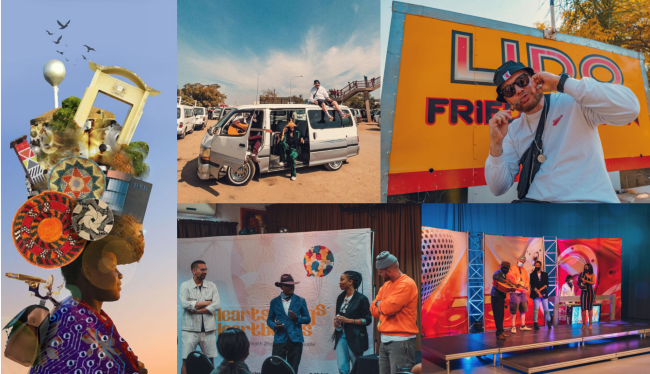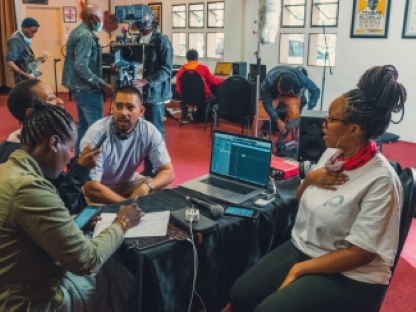 Graphic Thabo Seane. Photo Credit | Heartstrings & Heartbeats Project, His & Hers Luxury - Andra Ignatencu
Graphic Thabo Seane. Photo Credit | Heartstrings & Heartbeats Project, His & Hers Luxury - Andra Ignatencu
Harnessing projects and networks in African cities for social innovation and science advancement
Since Africa’s inclusion in the global economy in the 1990s, there has been a consistent trend away from reliance on economies based on resources, retail and manufacturing towards economies based on services (Anyanwu, 2012: Blankley & Booyens, 2010). More ambitious policies project a shift from services to advanced financial services and the so-called knowledge based economy derived from research, innovation and the ability to transact in Intellectual Property (IP) or human capital developments (Adejumobi, & Olukoshi, 2008: Government of Botswana, 2016).
Shifts in economic policies in Africa are generally designed within economic coordination blocks of several neighbouring countries who share regional challenges. Organisations such as Economic Community of West African States (ECOWAS) and the Southern African Development Community (SADC) are mandated to harmonise trade, currency and tariffs but also share agreements between research and academic institutions and protect IP (Abass, 2000: Saurombe, 2012: Kongolo, 2000). Therefore, one could argue that at a regional level, Africa is organised eco-systemically through the identification of different strengths, institutional resources, macro policies and positional advantages.
However, this blueprint of comprehensive and complementary cooperation often faces the challenge of implementation within participating national states and within the institutions that regulate and invest in markets as well as knowledge producing organisations (Hope, 2002: Khandelwal, 2004: Chingono & Nakana, 2009). It is within the context of this implementation challenge that African cities have been raised to the same level as states and national economies for their possible role in facilitating advanced services and knowledge based economies (Abrahams, 2009: Williams, 2000: Parnell Oldfield, 2014).
African cities are the primary capacity builders and drivers of regional change and are therefore good candidates for efficiently implementing Africa’s anticipated role in a knowledge, innovation, science advancement and change-embracing multipolar global economy that is becoming more receptive to the wide variety of skills, services and content that exists throughout Africa (Abrahams, 2009: Williams, 2000: Parnell & Oldfield, 2014).
Cities as drivers of Innovation
The emphasis on cities as global gateways and hubs raises the question of whether models of city management exist that can be relevantly applied to African cities. Since the inception of the so-called post-industrial or knowledge based economies, there have been a number of scenarios involving new markets and new roles for institutions and human capital in which cities play a fundamental implementing role (Scholvin et al, 2017: Parnell & Oldfield, 2014). The most prominent of these was the notion of the creative capital city which distinguishes itself among rival cities for its ability to attract and retain corporations and organisations whose purpose is to create and sell innovations (Krätke, 2012: Evans, 2009). Such entities are seen as having a less problematic, and particularly environment risking, impact on a city and its region than manufacturing. They are seen as able to generate higher revenues per capita than manufacturing, retail and services and thus decrease the demographics of a city while offering equivalent or higher tax contributions (Scott, 2006: Florida, 2003).
However, a city management that appeals to such organisations through incentives alone has many competitors. In order to successfully attract creative sectors and innovation-driving institutions, a city management has to appeal directly to the needs and interests of the personnel that such endeavours require (Florida, 2003). A city has to work in synergy with the organisations that it aims to host in order to be attractive to the profile of people such organisations wish to attract and retain. To solve this problem, Richard Florida put forward his sociological characterisation of what he called “The Creative Class” (Florida, 2002).
Florida’s advice to policy for city management is to bypass the usual engagement with corporates and sectors, and instead to concentrate directly on attracting the type of human capital that is necessary for the growth of an innovation-based sector. Florida’s analysis identifies three important dimensions of a city to be managed according to specific indicators. The first is to ensure all of the provisions by which what he calls Talent (innovation capabilities) can be sustained and developed simply by living and working in a particular city. The second dimension calls for city management to ensure that competitive Technologies of all kinds are available in the city at affordable rates. The final dimension is the promotion of Tolerance as a leading civic virtue. This is to ensure the heterogeneity of 'The Creative Class' and their sense of inclusion, acceptance and freedom from marginalisation while residing in the city. Florida's 2002 article published in the Washington Monthly, although perhaps reflecting the social language of the time, summarises his interesting views with the sub-title; “Why cities without gays and rock bands are losing the economic development race” (Florida, 2002).
The strengths and weaknesses of Florida’s '3Ts' criteria have been extensively debated but their underlying principle has been widely accepted. That principle requires that city managers driving the economic makeover of a city should; identify the institutions, practices, existing communities and traditions that support their IP development and innovation (which obviously places science advancement in the centre), ensure access to communication and information, and the sense of safety and belonging of individuals.
This is a very different approach to previous policies that aimed to closely articulate cities to corporations while embedding both in national economic policies and trends. The post-Florida approach identifies distinctive and sometimes unique qualities of cities and their regions as resources to be managed by civic administrations with a view to gathering human capital, attractive leading trends and to investability. The 3Ts dimensions contain indicators that allow cities to position themselves in the experience of certain kinds of individuals such that the city uniquely becomes the preferred site of their networking.
This approach to preparing cities to play a pivotal, if not leading, role in bringing about knowledge based economies amounts to a system and a methodology for making networks emerge and function optimally in cities. The 3Ts are drivers for recruiting individuals possessing valuable IP and the skills to realise this IP commercially into networks. It is the role of cities to make networks attractive and the role of institutions within those cities to facilitate transactions of the products of networks globally and of the increasingly productive interactions within the networks.
This city change management strategy is complemented by recent work on the sociology of projects as primary vehicles for cross-sectional collaborations for relevant developments and the provision of goods and services (Boltanski & Chiapello, 2005). The so-called project economies is presented as the preferred vehicle of a post-industrial knowledge and advanced services based economy because projects easily facilitate networks of people and their ideas providing an opportunity for innovation (MacCallum, 2009). They highlight the inefficiency of retaining diverse resources with a large organisation aiming for a market or price monopoly since the successful sail of innovation does not depend on either of these.
Projects enable innovation driven processes of value addition and creation to easily attract and facilitate stakeholders that may bring mutual benefits and sustainability. When projects are provided with adequate support and managed by a variety of stakeholders, feedback of their performance is less complex and provide implementing teams and investors with a better understanding to design the next projects.
To these facts, poorly managed and disorganised cities can bring ruin and further entrench wicked problems that exacerbate health problems. Cities convene the human capital, infrastructure, financing and the right minds through project networks to work together for various reasons such as administering the sovereignty of states, managing health, transport and communication and many others. How cities organise themselves determines the extent to which they are affected by challenges they face including wicked health challenges. Therefore it is safe to argue that the worst disorganised cities receive the worst consequences of poverty, climate change, health challenges and many more. Sustainable ecosystems that can advance science development must always be explored from the perspective of a city that can organise itself better. A city is the best definer and host to diversity and inclusion, a point where the best minds convene to solve humanity’s problems. The race to host the most brilliant minds in the world has defined the immigration policies for many states. The social cohesion of a city is the best starting point to investing in sustainable ecosystems that are mutually beneficial to stakeholders of culture, science, business and policy.

 Photo Credit | Heartstrings & Heartbeats Project, His & Hers Luxury - Andra Ignatencu
Photo Credit | Heartstrings & Heartbeats Project, His & Hers Luxury - Andra Ignatencu
The city will bring innovations on a large horizontal scale that benefits diverse people wherever they are, while projects will organise those people and connect them to the right organisations, adding value to their work or knowledge. This allows the creation of sustainable solutions to wicked problems that are relevant to local knowledge and aligned to trends and markets. To apply our methods, we recently started the Heartstrings and Heartbeats project, within a programme that explored Gaborone in Botswana as an ecosystem. The Heartstrings and Heartbeats project explores mental health among creative people and their communities by convening a diverse team of creative artists (particularly musicians) and scientists, the type of people who are rarely known to work together. We began with a cultural exchange exercise that brought Danish and British based artists in Gaborone to collaborate over music that challenges mental health conversations from the perspectives of their own cultures. The first things that our guests fell in love with were the warmness and friendliness of people in the city and the food. Without mention, the sense of safety while they visited. While it is too early to determine the impact of the project, some impact can already be foreseen based on the networks that the project established beyond itself. Despite constraints of the Covid-19 pandemic and misaligned institutions, within a single small project, there is continuation of the relationships outside the work. Those who are involved in the project have the opportunity to access markets that were initially complex to access. It is therefore not surprising that an investment in a city’s counter-culture of food, music, nightlife, technology and the safety of those who live in it, is the greatest investment that triggers an ecosystem that could advance science development.
When it comes to project management and IP development, the science community and its funders have been doing it for the longest time. Therefore, this era of investing in cities and projects favours science development to a great extent. The only focus and challenge for the scientific community is realigning their strategies to making sustainable projects that bring mutual benefits to science development, communities, business and policy stakeholders. These views therefore argue that city management can no longer be left to the city hall/council alone and science development can no longer be left to scientists alone. In modern times innovators and IP generators are outside the university walls and do not care so much about science development or city management, rather they care about expressing themselves, safety, friendships and the unlimited fun while they are in the city. Therefore it is best to build an ecosystem that enables networks and projects to form and be invested upon easily.
Third Stream Income in Cities
Knowledge is now ecosystemic. Universities particularly in Africa find themselves in a tough position where the investment in R&D is dwindling due to prioritisation of government spending. Teaching is also receiving pressure due to technological advancement, more and more people are learning from the internet and sharing techniques and skills for free. The majority of people are in jobs within fields that they did not study in universities, rather they pick-up skills through convivial learning. For example, if you are to learn music production, who would you rather choose to teach you, Jay Z’s producer or a Professor in a university? A lot of young people would choose the former. This is evidence that knowledge has moved into the ecosystem and universities must follow it.
It is in the ecosystem where universities can gain their ability to be ahead of markets and trends. Therefore gaining an advantage to earn income from projects and becoming part of the industry. In this regard universities are forced to play a role in the organising/alignment and development of cities' ecosystems that translates to policies, partnerships, infrastructure and financing. Through these, the so-called third stream income will emerge in the form of taxing projects that are facilitated by the cities benefiting both universities and their partners directly into R&D.
An Opportunity for Philanthropic Bodies
There is an existing opportunity for large international philanthropic bodies that wish to advance science development such as Wellcome, Bill & Melinda Gates Foundation, the UK's National Institute of Health Research and many others. The interest to develop ecosystems that support science advancement has been ongoing for years. Such conversations have been mostly concentrated in science development as a single unit. It is however important to acknowledge that science engagement has been a commendable effort by organisations such as the Wellcome to try and advance science for the benefits of health improvement. Science engagement has been a point to strike conversations and bring stakeholders outside science closer to science. However, the arguments placed above indicate that investing in dimensions such as the development of human capital, infrastructure and finance resources is inadequate.
There is little effort made in investing in social cohesion, which is the cultural layer for societies that are involved in different regions with their cultures. Africa is a huge continent with many varied cultures which makes it even more complex. Those cultures that define the social cohesion determine the success of projects, or whether ecosystems become effective or not. A simple thing such as the effective use of a vaccine or its acceptance is to a great extent determined by the culture of a certain society. The same applies to advances in science and innovation. Therefore ecosystem strategies must to a great extent focus on investing in cities' social cohesion as ecosystems and science engagement as an alignment tool in order to advance science.
As a horizontal strategy, cities must then be utilised to manage the sustainability of projects with the view that investing in projects that are within well organised cities is an opportunity to invest in well functioning ecosystems that can advance science development. However, it is worth noting that, when it comes to such the game is of a different nature as politics is involved. Most philanthropic organisations try to avoid politics at whatever costs, which demands that there has to be strategic partnerships with government departments, such as the Foreign, Commonwealth & Development Office (FCDO), to manage political expectations and interests. The opportunity therefore lies in the partnership between stakeholders of culture, science, business and politics by achieving economies of scale towards achieving mutual benefits.
While there are concerns about the increase of wicked problems such as climate change, poverty, unemployment, poor health and many other challenges that are caused by overpopulation in cities, the same cities are the best starting point to overcome the wicked problems we face. New city regeneration strategies and programmes are the best options to build functional sustainable ecosystems. It calls for a deliberate utilisation of cities as conveners of diversity of skilled and non-skilled people to advance science or to build progressive ecosystems that bring about mutual benefits to all stakeholders. Thus, in order to solve mental health for example, you don't just require psychiatrists to convene over this wicked problem, you also require city planners, urban designers, design thinkers, politicians, mathematicians, musicians and street artists and street food sellers. Our best chance to win future pandemics is determined by how cities organise their best brains to convene over a crisis through projects.
Abraham Mamela is CEO and Founder of Infers Group and a Wellcome Engagement Fellow
Find out more about Heartstrings & Heartbeats
This work is licensed under a Creative Commons Attribution 4.0 International License
Also By
- Guía Práctica para Planificar una Estrategia de Participación Social (CEI) para una Propuesta de Investigación de Salud Global
- Guide: A Practical Guide to Planning an Engagement Strategy for your Global Health Research funding application
- Article: A New Age of Project Value Chains and Networks in Africa


Please Sign in (or Register) to view further.